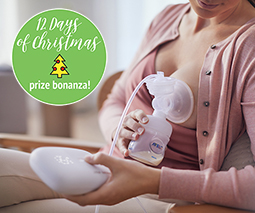How to get the correct nipple latch while breastfeeding your baby

When it comes to breastfeeding your baby, getting the right latch is everything. If your baby doesn’t latch on to your breast efficiently, this can affect how well milk is transferred from the breast (which in turn affects supply) and can also contribute to nipple pain. While breastfeeding is a natural process, it can still take some practice before you and your baby get that all important latch right.
Does your nipple shape impact your baby’s latch
Having especially large or small nipples will not affect your body’s capacity to breastfeed, just as having big or small boobs doesn’t. Some women have inverted or flat nipples, but this also doesn’t need to hinder breastfeeding, and you don’t need to do any special preparations while your pregnant if this is the case for you. You’ll find that your nipples become more supple during pregnancy and that your baby will still be able to feed from you. Using a breast pump or hand expressing can help draw the nipple out for feeds. Be sure to get some extra support from a breastfeeding counsellor or lactation consultant, who can assist you while you establish feeding with your newborn. If you continue having problems, a nipple shield may be recommended to you, but please seek advice before using this.
Read more about breastfeeding:
- How to prepare yourself for breastfeeding
- 9 tips you need to know about nipple care while breastfeeding
- 7 things you’ll miss about breastfeeding when your kids are grown
Getting the right latch
For your baby to latch on to your breast correctly, she needs to take as much breast into her mouth as possible and draw your nipple up towards the soft palate area of her mouth. If your breast isn’t drawn into her mouth enough, your nipple will be forced onto the hard palate area, which will cause you discomfort and pain.
To find out where the soft palate area is, put your finger inside your mouth and feel the roof of it – most of it feels hard, however right at the back, almost where the roof of your mouth meets the top of your throat you’ll notice a soft area, called the soft palate. This is also known as the ‘comfort zone’. When your nipple is drawn this far into your baby’s mouth, you’ll have achieved a deep latch and should not feel any nipple discomfort.
How to encourage the deep latch
First of all, you need to find a feeding position that is comfortable and suitable for you and your baby. Whatever position you use, ensure that your baby is tucked in closely to you and doesn’t have to turn her head towards the breast. If you are using baby-led attachment, place your baby on your chest and allow her to bob her way towards your breast. This may take some time, but many babies can find their way to the breast and latch on efficiently in this manner.
Alternatively, you can help place your breast in your baby’s mouth by encouraging her to open wide (tickling the tip of her nose with your nipple can help here) and once she does this and you notice her tongue coming forward over her lower gum, you can quickly place your breast in her mouth, pointing your nipple at the roof of her mouth, aiming for that soft palate area.
How to know if the latch is right
As your baby’s mouth closes over your breast, you’ll notice her mouth is spread quite widely across your areola and her chin is pressed into your breast with her nose clear or just touching it. You should notice no pain (if you are brand new to breastfeeding, you may have some stinging as your baby attaches but once your milk is flowing this should stop). You will notice your baby drinking milk from you, with her jaw moving rhythmically as she sucks.
If your baby latches on and you can see that it doesn’t look or feel right, simply insert your clean pinky finger into the corner of her mouth to break the suction and try again.
If you need more help
If you are having trouble getting your baby latched on, of if breastfeeding is causing you too much pain, seek advice as soon as possible – ideally before you leave the hospital. Alternatively, if you have a midwife visiting you at home, make sure she checks your latch and positioning as sometimes a simple adjustment can make all the difference. You can also contact the Australian Breastfeeding Association on 1800 686 268 and speak with a trained breastfeeding counsellor.













